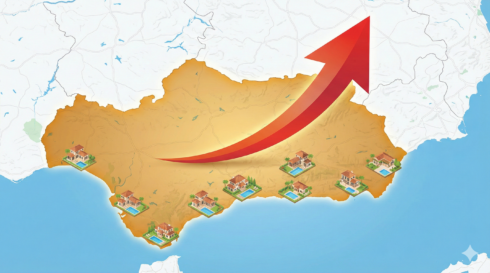PICTURE the scene: it’s midnight on All Hallow’s Eve, the Witching Hour is upon you and flying above you are silhouetted figures with pointed hats, riding broomsticks, each with a black cat sat behind them. Their shrieking and cackles pierce the night sky.
Ok, so maybe it sounds a little far-fetched, but with Halloween looming this Saturday there’s no doubt you’ll come across a fair few witches and goblins on your evening out. The only big difference is that most of them won’t be flying.
So, who exactly decided that witches graced the night skies wearing capes and conical hats, and what is the history of witchcraft in Spain?
Witches, traditionally, were followers of paganism – a nature-based religion, which practised ritual magic. Paganism dates as far back as 600AD, but its exact origin is unknown.
It was not until the mid 15th century however, that its popularity was seen to be a problem.
Broadly speaking it came to be considered as heretic, or opposed to Christianity.
In Spain, in particular, witches formed groups, called covens, in many provinces. The most famous of these were in the Alpujarras.
In Andalucia, traditional witchcraft was not as culturally dominant as other crafts such as ‘curanderos’ – or healers, as well as ‘sabios’ – wise men, or shamen.
Andalucians believed that they could cure people and animals of illness, predict the future and improve crop growth.
Curanderos are still often sought around the region for a variety of illnesses and health complaints, while witches still have negative connotations associated with them.
Through Spanish history, it was women marginalised by Spanish communities, particularly gypsies, who were accused of having an ‘ojo de malo’ – or evil eye.
Any of these women could supposedly curse someone just by looking at them.
When it comes to pointy hats, it was actually the Christian church in the UK that led to witches wearing them.
During medieval times – when witches were widely feared and hunted down – the hat was placed on a woman’s head to identify her to others.
Called a ‘steeple-crowned hat’, it derived from a ‘steeple-house’, the word puritans used to refer to the church. It was hoped that placing this holy symbol on a witch before burning her at the stake would lead to her salvation.
Of course, we’re not just led to believe that witches wear hats. They also have a close friend beside them on their travels – a black cat.
Superstition and folklore always associated cats as being a witch’s best friend. In the middle ages people believed cats were sometimes even witches incarnate.
They were seen to be evil and were often associated with supernatural beings – people believed they were witches’ servants.
In the UK, black cats are seen to be lucky omens, apart from when one crosses your path. However, in Spain, it turns out, they are purely regarded as bad luck.
In fact, when witches were captured and tried, their cats were subjected to the same fate as their alleged masters.
These terrible punishments were fairly similar from country to country. Both the British and Spanish burnt witches at the stake, as it was commonly believed burning them would purify their blood.
However, a British witch was more likely to be hunted down by the village mob to face an impromptu kangaroo court that would inevitably lead to her death, while the Spanish had an organised body, the Inquisition, to track them down and charge them with heresy. They were unlikely to survive unscathed.
The grotesque punishment of ‘the wheel’ was also a popular form of executing witches in Spain.
The victim would be stretched across the spokes of a giant wheel. Then, her limbs were shattered by a heavy iron bar, causing a prolonged and extremely painful death.
During this time of persecution, witches did anything possible to conceal their heretic beliefs. An object that commonly symbolises witches is the broomstick.
Yes, they really did carry broomsticks, but in an attempt to hide them, witches would wrap anything they could find to try and disguise what they really were.
There are two main beliefs about the importance of the broomstick to a witch, one of which has a far more innocent connotation than the other.
As part of their pagan ritual, witches believed a fertility ritual could be performed with the aid of a broomstick. In an attempt to encourage crop growth, women would straddle a broomstick then repeatedly jump back and forth over a plant that needed some extra assistance.
They believed doing this would help the crops grow big and strong.
This ritual was usually undertaken under the light of a full moon, as in pagan tradition, it is believed the moon has a strong effect on nature. Anyone who observed the ritual of the leaping witches might well have thought they were flying.
The other theory about witches’ broomsticks requires you to think more literally about the witch riding the broomstick.
A number of Spanish witches admitted during their inquisitions that they engaged in night-flying.
Witches would rub an ointment made with ergot onto the end of their broomsticks and quite literally sit on it.
This is because witches would use hallucinogenic drugs to get high and make them believe they were flying.
Their way of administering the drugs was rather novel even by modern day standards.
The hallucinogenic they used was called ergot, it came from a mould that grew on rye bread.
In high doses ergot is fatal, but small amounts would lead to extremely intense experiences.
Therefore, in order to avoid the risk of death, witches looked for alternative ways to absorb the drug quickly into their blood stream.
The most effective way, and the one with the least ill-effects, was through the female genitals.
Witches would rub an ointment made with ergot onto the end of their broomsticks and quite literally sit on it.
A woman, not only in the throes of hallucinations but also ecstasy, would have terrified anyone unfortunate enough (or fortunate, depending on what tickles your fancy!) to have come across her.
The famous images of witches riding a broomstick have been inspired by the hapless folk who unwittingly stumbled across these highly-charged rituals.
So if you’re out and about this coming Halloween, keep a wary eye peeled for any Spanish party-goers, dressed as witches who appear to be enjoying themselves just a little too much.
You never know what ancient rituals they may have sampled to get into the spirit of things!
Click here to read more News from The Olive Press.






Note… ‘heretic’ does not mean ‘opposed to Christianity’.
The word is derived from the Greek meaning ‘school of thought’ as in ‘different school of thought’ only.
Much of what you have written here on Witchcraft is based on superstition and urban legend, not fact.
Religions considered to be Pagan go back long before 600 AD but it was a term used by Christians, not a term that any of those religions would have used. Even today older Pagan religions such as the Hindus would get rather upset if you used the term Pagan about their religion.
As for the religion of Witches, no one really knows if Witches had a religion, much less a Pagan one. At the same time it would appear that Witches could follow any religion, after all we have had centuries of Christians ones, particularly in Catholic countries.
Pagan? *laughing* Yeah, okay, pagan was a word that meant ‘bumpkin’ basically. As in Christians would call people who weren’t as well ‘educated’ as themselves ‘bumpkins’ because they were from out in the boonies. Because there weren’t enough priests or monks traveling a region, ‘paganism’ had an easier time of staying in the foreground for many individuals, thus Christains called them ‘pagans’. And wow, how much research was actually put into this article? Really? It’s about as sensationalized as that dumb movie from the early 90’s Hocus Pocus.
And as innacurate.